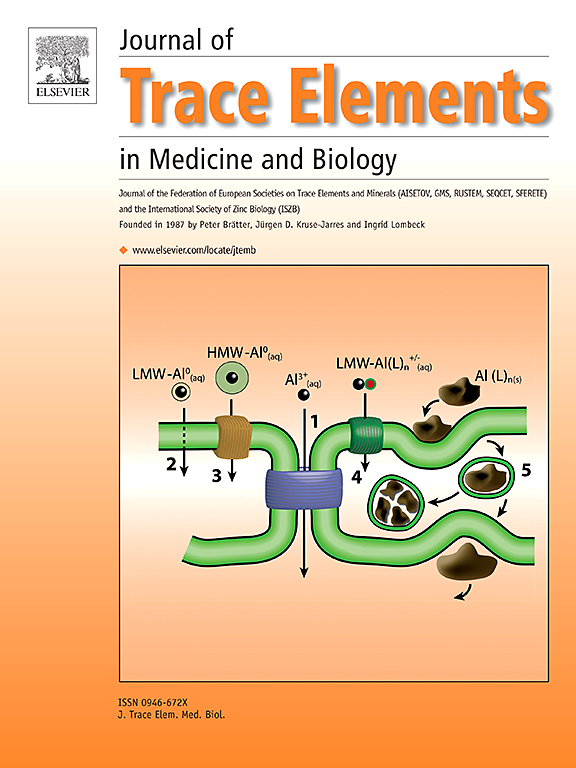The variability of selenium and sulphur and the impact of creatinine in blood and urine of humans
IF 3.6
3区 医学
Q2 BIOCHEMISTRY & MOLECULAR BIOLOGY
Journal of Trace Elements in Medicine and Biology
Pub Date : 2025-07-23
DOI:10.1016/j.jtemb.2025.127700
引用次数: 0
Abstract
Background
Intake of selenium (Se) and sulphur (S) is mainly through meat and fish. This is also the case for creatine, which is broken down into creatinine (Crea).
Objectives
Objectives were to assess variability of Se and S in urine and blood, assess diurnal variation and associations with Crea in urine (U-Crea).
Methods
Urine was collected at six fixed times for 24 h, and repeated one week later among 29 males and 31 females. Blood was collected at both occasions.
Results
Mean 24 h urinary excretions of S (U-S24 h) and Se (U-Se24 h) on the first sampling day were 756 mg and 23 µg, respectively. U-S24 h and U-Se24 h were highly correlated (r = 0.75; p < 0.001). Diurnal variation in the urinary excretion rate (ER) of S and Se was associated with urinary flow rate (UFR). Mean urinary concentrations of S and Se varied substantially during the day, except Crea adjusted concentrations. The 24 h U-Crea excretion was associated with U-S24 h (r = 0.81; p < 0.001) and U-Se24 h (r = 0.60; p < 0.001). The U-Crea ER were associated with those of S (r = 0.74; p < 0.001) and Se (r = 0.83; p < 0.001). The highest intraclass correlation coefficients (ICC) for Se was for the blood cellular fraction (0.898) and U-S24 h (0.529) for S.
Conclusions
The urinary S and Se ER were highly associated with Crea ER, which has previously not been shown. This suggests that Crea corrected values should be interpreted with caution. Biomarkers of Se in blood had the highest ICC, while ICCs for S were generally lower. ICC of S and Se has rarely been studied. There was a slight diurnal variation in urinary ER of S and Se which was weakly associated with UFR.
人体血液和尿液中硒和硫的变化及肌酐的影响
硒(Se)和硫(S)的摄取主要是通过肉和鱼。肌酸也是如此,它被分解成肌酸酐(Crea)。目的评估尿和血中硒和硫的变异性,评估尿中硒和硫的日变化及其与Crea (U-Crea)的关系。方法每6次固定采集尿液,每次24 h,一周后重复采集29例男性和31例女性。两次都采集了血液。结果第一天24 h平均S (U-S24 h)和Se (U-Se24 h)排泄量分别为756 mg和23 µg。U-S24 h与U-Se24 h高度相关(r = 0.75;p & lt; 0.001)。S和Se的尿排泄率(ER)的日变化与尿流率(UFR)相关。除了Crea调整的浓度外,S和Se的平均尿浓度在白天变化很大。24 h U-Crea排泄与U-S24 h相关(r = 0.81;p <; 0.001)和U-Se24 h (r = 0.60;p & lt; 0.001)。U-Crea ER与S相关(r = 0.74;p <; 0.001)和Se (r = 0.83;p & lt; 0.001)。组内相关系数(ICC)最高的是血液细胞分数(0.898)和S的U-S24 h(0.529)。结论尿S和Se ER与Crea ER高度相关,这在以前的研究中没有发现。这表明Crea修正值应谨慎解释。血液中生物标志物硒的ICC最高,而S的ICC普遍较低。S和Se的ICC研究很少。尿ER中S和Se的日变化较小,与UFR相关性较弱。
本文章由计算机程序翻译,如有差异,请以英文原文为准。
求助全文
约1分钟内获得全文
求助全文
来源期刊
CiteScore
6.60
自引率
2.90%
发文量
202
审稿时长
85 days
期刊介绍:
The journal provides the reader with a thorough description of theoretical and applied aspects of trace elements in medicine and biology and is devoted to the advancement of scientific knowledge about trace elements and trace element species. Trace elements play essential roles in the maintenance of physiological processes. During the last decades there has been a great deal of scientific investigation about the function and binding of trace elements. The Journal of Trace Elements in Medicine and Biology focuses on the description and dissemination of scientific results concerning the role of trace elements with respect to their mode of action in health and disease and nutritional importance. Progress in the knowledge of the biological role of trace elements depends, however, on advances in trace elements chemistry. Thus the Journal of Trace Elements in Medicine and Biology will include only those papers that base their results on proven analytical methods.
Also, we only publish those articles in which the quality assurance regarding the execution of experiments and achievement of results is guaranteed.

 求助内容:
求助内容: 应助结果提醒方式:
应助结果提醒方式:


